Archive for the ‘Green Roofing’ Category
New Law Calls For Solar Roof Installations
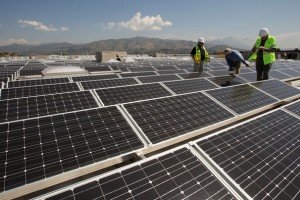 Many large commercial buildings around the country are installing solar roof panels to reduce the reliance on traditional energy sources. While national efforts are beginning to pick up speed, many other countries are taking the green roofing industry by storm. A new law proposed in the Philippines is calling for a massive installation of solar panels across the city.
Many large commercial buildings around the country are installing solar roof panels to reduce the reliance on traditional energy sources. While national efforts are beginning to pick up speed, many other countries are taking the green roofing industry by storm. A new law proposed in the Philippines is calling for a massive installation of solar panels across the city.
Unified Efforts
If a single residence home can generate enough electricity to power itself for 24 hours, imagine what an entire city’s worth of solar power could generate. A progressive lawmaker in Davao City, Philippines is working on a new bill that would change the country’s energy sector.
Senator, Teddy Casino and a group of solar technology developers, the Philippine Solar Power Alliance (PSPA) are working on a plan to install solar panels on the rooftops of houses, buildings and commercial establishments. Deemed the One Million Solar Roofs Act of 2011, the House Bill was designed to “promote the utilization of renewable energy resources to reduce dependence on imported energy from fossil fuels.”
If approved, the PSPA would being installing new roof solar panels among 10 percent of residential units per year. Over time, the project would be able to “promote energy stability and independence from imported energy sources, mitigate global warming and air pollution and encourage industry growth that will lead to more jobs and lower electricity bills.”
Green Roof for Girls Boarding School
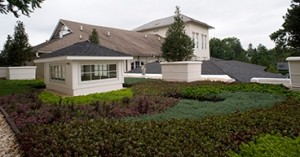
In Lititz Pennsylvania, Linden Hall School for girls has just opened their new Evita M. Allen Center for Academic Excellence. The new 28,000 square foot facility has the first green roof in Lititz. The green roof will improve the air quality and reduce and purify rain water runoff.
Keystruck Construction Inc. began the project in May 2011 and completed it in August 2012. Chambers & Associates Inc. designed the center and Erb Brothers Landscaping, Creek Hill Nursery and Derck & Edson Associates handled the landscaping and plants.
Using the LiveRoof tray system, Steve Sproles of Derck & Edson said “trays often come premixed, but this new roof was custom designed to feature waves of color and plants that flower in different seasons, as it is easily visible from the school’s library.”
Along with the living roof that can be viewed from the third floor porch, the new center houses the school’s administrative offices, a multimedia library and research center, flexible classrooms and a new computer lab.
Founded in 1746, Linden Hall is the nations’ top ranked college preparatory school in the United States. The 47 acre campus is a day school and boarding school for girls.
Massive Green Roof for Portland Walmart
People of Portland Oregon typically oppose such large construction in their neighborhoods, but with the promise of the largest green roof in Oregon, they seem to be onboard.
Construction has recently begun on the 90,000 square foot facility in North Portland; the green roof will be 40,600 square feet. The store is scheduled to open in fall 2013.
The new roof was designed by the Audubon Society of Portland, Urban Greenspaces Institute and several other organizations.
The roof will have 3 levels, each approximately 13,000 square feet. The different sections will contain different levels of soil that will assist the Bureau of Environmental Services during a three year water run off performance study to determine which soil works best to reduce storm water runoff. The roof will also consist of compost piles and water basins in an effort to create wildlife habitats. Another section will contain a rougher soil determine what kind of plants can adapt and survive on the rooftop environment.
Green Roof Benefits
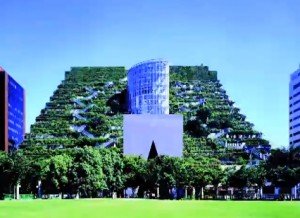 Like all environmentally friendly products green roofs offer an extensive variety of benefits to the earth, as well as its inhabitants. Green roofs have been around for centuries, but are just now gaining popularity in America’s urban areas.
Like all environmentally friendly products green roofs offer an extensive variety of benefits to the earth, as well as its inhabitants. Green roofs have been around for centuries, but are just now gaining popularity in America’s urban areas.
Making A Difference
Why would anyone want a roof covered in vegetation and plants? For one, green roofs are great for rain water management. Acting like sponges, the plants covering the roof absorb the rainwater and filter it, releasing a cleaner water waste product. The filtered runoff contains less toxins and chemicals than traditional rainwater runoff, which also ease the polluting of other nearby vegetation.
The vegetation also lowers the amount of CO2 and pollutants directly from the air, leaving the air cleaner and less toxic to breath. When these traditional toxins are removed from the air, the ambient temperatures are lowered and have a cooling effect. Green roofs can lower the temperature of the building itself by absorbing and distributing heat, preventing it from being absorbed into the building. Lower building temperatures means a reduced need for electrical cooling systems, another environmentally friendly outcome.
Urban areas stand to gain the most from green roofs, as they provide a much needed green space in a cement covered city. Rooftop gardens are common among green roof systems, giving residents a place to grow fresh fruits and vegetables. Equally important is the reduced noise pollution in areas surrounded by vegetation and reduced need for maintenance. Green roofs are one of the best roof systems in terms of the fact they rarely need roof repair, which then reduces the costs associated with maintenance.
Our Future With Solar Power
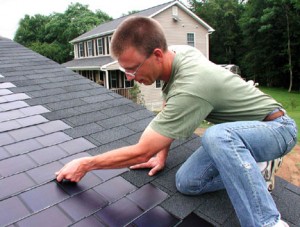 There has been much attention in recent years to protecting the environment and reducing our dependence on traditional energy sources. When it comes to roofing, solar panels and green roofs can certainly do their share for reducing our carbon footprint, so why aren’t they more common?
There has been much attention in recent years to protecting the environment and reducing our dependence on traditional energy sources. When it comes to roofing, solar panels and green roofs can certainly do their share for reducing our carbon footprint, so why aren’t they more common?
Misunderstood Materials
Solar roof panels are made up of several individual photovoltaic cells, which convert the sun’s rays into electrical power. Manufacturing of these panels can be expensive, one of the main reasons why people shy away from using them on residential homes. Some argue that the manufacturing process uses a lot of energy itself, thus nullifying the benefit of the product once produced. While these arguments cannot be disputed, it doesn’t necessarily mean that solar roof panels are not a better option in the long run.
First, consider the average household and its electrical use. A 10 by 10 foot solar panel can generate enough electricity to power the average American home for 24 hours. Think about the reduction in the utility bill when the average electrical use per day is provided by the solar panel. Over all, the cost of installing a solar roof panel is far cheaper than one will spend in a lifetime of paying for traditional energy.
Not only will homeowners save money, but they will be using less than 10% of traditional energy sources than before the installation of solar panels. This is extremely helpful during hot or cold weather when traditional electric sources may go off the grid for a period of time with rolling blackouts. When the dependence on traditional energy sources is reduced, the use of coal and other hazardous material manufacturing will be reduced.
Just imagine the outcome we could achieve if more homes and commercial buildings installed solar roofs.
Installing a Green Roof
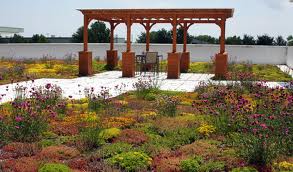
When you are thinking of adding a green roof to your home there are a number of things to consider. Intensive and extensive are the two main types of green roof.
An intensive green roof can hold a rooftop garden, trees, bushes, benches and paths by adding additional support to your roof. You will need to consult a roof contractor or engineer to determine if your home will need additional structural changes to support the extra weight on your roof.
An extensive green roof requires less support and usually only has indigenous ground cover. If you can ensure your roof is able to hold 27 pounds per square foot, you may be able to add this type of roof yourself. If in doubt, check with a professional and always follow your local building codes.
Decide What You Want to Grow
Both types of green roof involve placing a waterproof barrier between the roof decking and soil to prevent water from damaging your roof. It may also include a root barrier and drainage or irrigation system. Next is a growing medium and then the plants.
Both roof systems last longer than conventional roofs. They provide additional insulation and help reduce your energy costs by keeping the temperature of your rooftop cooler in the summer months. The greenery also improves air quality by removing pollution and producing oxygen. Green roofs also absorb storm water keeping it from overburdening city sewer systems. They also create a habitat for wildlife.
Green Roof Testing at Virginia Tech
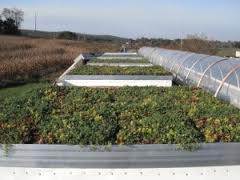
Architecture and Urban Studies at Virginia Tech students have been researching the effects of green roofs and controlling urban runoff. Early results were recently released from the 2 year project. Not only do green roofs provide shade and help cool buildings by the extra insulation, they also reduce the force of storm water runoff. The vegetation acts like a sponge absorbing and filtering water that would normally rush into city streets and into the overburdened sewers.
Elizabeth Grant, assistant professor of architecture and lead investigator for the project said “We want to determine the effectiveness of various depths and types of green roof systems.” She went on to say “before designing these systems architects need to be able to answer this question, how well do they work?”
Different Depths for Platforms
By using 8 by 8 foot elevated platforms, the students determined that green roofs reduced and slowed runoff during the first 5 months. The plywood platforms were covered with white reflective thermoplastic roof membranes and three different depths of modular green roof covering; 6 inches deep, 4.25 inches standard and light at 2.5 inches. Also included in the study was a control platform and a 4.25 inch depth of growing medium, but no plants. A weather station recorded air temperature, humidity, radiation, rainfall and wind speed and direction.
49 storms were recorded and results were the deep, standard, light and medium only platforms retained more water than the control platform. Overall, the deeper systems held more than the shallow ones. The depth and other properties of the growing medium may be as critical as the vegetation to reducing storm water runoff.
The study will continue to evaluate how the weather and various types of green roofs reduce urban runoff. If you would like to know more about this project please visit www.vtnews.vt.edu.
Coca Cola Headquarters Gets A Green Roof
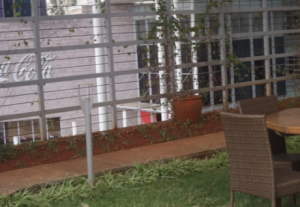 The green roofing industry has captured the attention of many big name corporations in recent years. The Apple headquarters has one of the largest solar roof panel displays in the United States, along with several IKEA buildings. As truly green roofs become more popular around the globe, the East African Coca Cola Company building joins in with a new rooftop garden.
The green roofing industry has captured the attention of many big name corporations in recent years. The Apple headquarters has one of the largest solar roof panel displays in the United States, along with several IKEA buildings. As truly green roofs become more popular around the globe, the East African Coca Cola Company building joins in with a new rooftop garden.
Corporate Green Initiatives
The headquarters of the Coca Cola Company in Nairobi, Kenya is home to one of the largest green roof gardens in the area. The building’s original design plans included an outline for the garden, aiming to lower cooling costs, reduce greenhouse gases and conserve the amount of energy used by the building.Although the building was completed in 2008, the garden has taken a bit longer to complete.
The flat roof designed building now boasts one of the city’s largest rooftop gardens that also includes a recreation are for company employees. Not only is the roof helping to boost local vegetation and product production, it also has helped reduce the amount of water consumption used around the building. Much of the waste water from the building is recycled and distributed to other parts of the building or garden from specialized tanks stored on the building’s roof.
The Coca Cola building roof garden has also inspired other green construction project ideas around the city. Kenya’s government officials are now considering several other green roof projects for other buildings around Nairobi and surrounding areas.
Green Roof Gardens
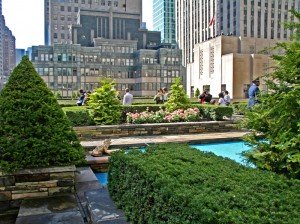 Although popular around the globe for hundreds of years, the United States is just catching wind of the benefits behind a green roof system. Not typically a part of a homeowner’s plan for a new roof, green roof gardens have become more popular in some regions.
Although popular around the globe for hundreds of years, the United States is just catching wind of the benefits behind a green roof system. Not typically a part of a homeowner’s plan for a new roof, green roof gardens have become more popular in some regions.
Urban Delight
One of the most popular areas in America for green roofs are the rooftops of urban buildings. Traditionally packed with concrete and loud appliances, many residential and commercial roofs are now being topped by lush gardens. Offering the local community a place to enjoy a green space, get involved in a small agricultural project and even develop crops for selling at the local farmers market, rooftop gardens are becoming a place for locals to meet.
What makes a good green roof garden? There are a wide variety of plants that can be used for rooftop gardens. Depending on the light conditions of the building, rooftop gardens can be planted with grass, flowers and even produce. The key is finding the best plant for the conditions of the building and level of attention required.
Grass is fairly low maintenance and can be great for enjoying quiet times in lawn chairs or playing with children. Flowers bring an aesthetic appeal, but often require more work for the garden attendants. Produce is an excellent crop for those looking to grow fresh fruits or vegetables. However, they often require dutiful maintenance to keep insects away and can be picky about light or soil conditions.
Dow Solar Shingles Sold in California and Texas
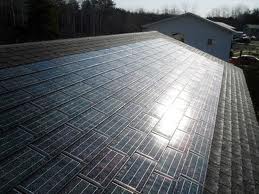
Dow Solar, a division of Dow Chemical announces their Powerhouse Solar Shingles will be sold in Central Texas and Northern California. Select roofing companies in these areas will be the first markets to receive the solar shingles. Previously the shingles were only available in Colorado.
The Solar Shingles are certified as both a solar and a roofing product. The roof shingles offer protection from the elements and also generates energy to offset energy costs. The shingles can be installed by a roofer along with the regular roofing materials.
The shingles are custom designed, and include an inverter that converts DC (Direct Current) into AC (Alternating Current) to power the home. The cells of the shingles are a flat laying thin film material that have about a 12% efficiency rate.
Safety and Perfomance
The roof solar system delivers real time production and consumption readouts from any internet connection. Dow Powerhouse Solar Shingles received 7 performance and safety certifications and is proven to withstand rain hail and wind uplift.
Dow spokesman Kate Nigro said the Powerhouse Solar Shingles cost 2-3 times more than standard roof shingles. The shingles are made in USA with a 20 year warranty. Dow hopes to sell the shingles in a dozen states by the end of 2012.







